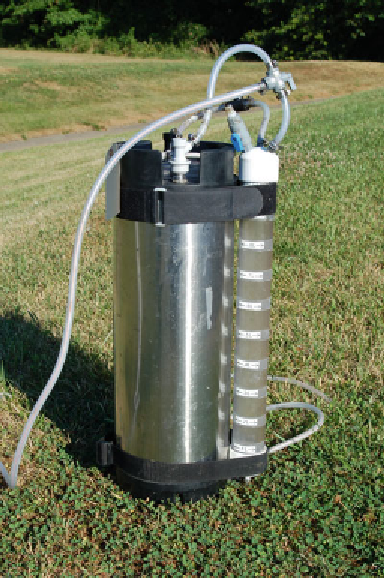Biomedical Engineering Reference
In-Depth Information
Figure 3.12. Stainless steel soda keg (5 gal/18.5 L) with attached measuring device, used to deliver
and inject Dhc-containing cultures. Most bioaugmentation vendors now use these, or similar,
containers to maintain anaerobic conditions during transport and injection of bioaugmentation
cultures. The attached measuring device is calibrated to allow accurate delivery of a desired
culture volume while maintaining anaerobic conditions.
top of the kegs. As gas (nitrogen or argon) is added through the “gas in” port, the culture is
expelled from the “liquid out” port. Flow of the culture from the keg can be controlled by
simple valves.
3.7 ONSITE HANDLING
Dehalogenating bacteria are strict anaerobes (He et al.,
2003b
;L¨ffler et al.,
2003
; Maym´ -
Gatell et al.,
1997
), and therefore exposure to oxygen should be prevented during any handling.
Most culture distributors now deliver cultures in containers, like those described above, that
allow the cultures to be anaerobically injected into aquifers with no exposure to oxygen.
3.7.1 Direct Injection
Bioaugmentation cultures can be injected directly into aquifers using direct push technol-
ogies, by adding them to injection wells or by adding them to recirculation systems. Prior to
injecting the cells, aquifers are often preconditioned to remove oxygen and lower the oxidation
reduction potential. Preconditioning is typically accomplished by injecting the planned electron
donor into the aquifer several days, weeks or months prior to injecting the culture.

Search WWH ::

Custom Search